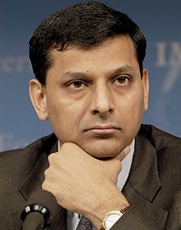Raghuram Rajan is Central Banker of the Year 2016
08 Jan 2016
 Reserve Bank of India governor Raghuram Rajan has been conferred with the Central Banker of the Year Award (Global and Asia Pacific) for 2016 by The Banker, a monthly publication of the Financial Times Group focusing on banking.
Reserve Bank of India governor Raghuram Rajan has been conferred with the Central Banker of the Year Award (Global and Asia Pacific) for 2016 by The Banker, a monthly publication of the Financial Times Group focusing on banking.
The Central Banker of the Year 2016 award celebrates the officials who has best managed to stimulate growth and stabilise his country's economy.
Recounting the Reserve Bank's achievements in the past year, the Banker says, ''India is the one global economy that arguably weathered the capital outflow and currency storms in emerging markets that were fuelled by uncertainty over the US Federal Reserve interest rate hike in 2015.
''At 7.4 per cent, India's 2015 third-quarter gross domestic product growth was the strongest among large economies; the rupee was one of the few stable emerging market currencies in 2015; and a clear financial market liberalisation path is attracting foreign investors and making India's financial markets more sophisticated.
''In recognition of the Reserve Bank of India's (RBI) contribution to these achievements, The Banker has awarded Raghuram Rajan with the title of Global and Asia-Pacific Central Bank Governor of the Year.''
When Rajan started his mandate, the rupee was in free-fall. In September 2013, the currency hit a record low of Rs68.12 to the US dollar.
Under Rajan's watch, the rupee's depreciation halted and the currency moved back below the Rs60 'psychological mark'. In 2015, the rupee held up while currencies such as the Malaysian ringgit fell by as much as 20 per cent against the dollar.
RBI's focus on taming inflation – India is set to hit its 6 per cent inflation target in 2016 – was key to this performance and reinforced foreign investors' confidence in India's currency and rupee-denominated assets. ''They are offering a healthy yield. And it wouldn't be healthy if inflation were high,'' says Rajan.
In his acceptance speech, Rajan said there is a need to avoid beggar-thy-neighbour policies and sustained exchange-rate intervention that primarily induce capital outflows and competitive currency devaluations.
This forces developing countries to use borrowed foreign exchange for importing goods and services from the developed world, thus accelerating the process of making the neighbour poorer.
"In an ideal world, the political imperative for growth would not outstrip an economy's potential. In the real world, where social-security commitments, over-indebtedness, and poverty will not disappear, we need ways to achieve sustainable growth.
"Above all, we need to avoid beggar-thy-neighbour policies, such as unconventional monetary policy or sustained exchange-rate intervention, that primarily induce capital outflows and competitive currency devaluations," he said in an article in 'Project Syndicate'.
According to Rajan, multilateral institutions like the International Monetary Fund should exercise their responsibility for maintaining the stability of the global system by analysing and passing careful judgement on each unconventional monetary policy (including sustained exchange-rate intervention).
"The current non-system is pushing the world toward competitive monetary easing, to no one's ultimate benefit. Developing a consensus for free trade and responsible global citizenship - and thus resisting parochial pressures - would set the stage for the sustainable growth the world desperately needs," he said.
Rajan said that developed countries have just one other channel for growth - boosting exports by depreciating the exchange rate through aggressive monetary policy.
"Ideally, emerging-market countries, funded by the developed economies, would absorb these exports while investing for their future, thereby bolstering global aggregate demand," he said.
Meanwhile, China on Thursday lowered the yuan's exchange rate against the US dollar by 0.51 per cent to 6.5646, the lowest since March 2011, helping to make Chinese exports cheaper and more competitive in the global markets.
Indian capital markets joined a global sell-off sparked by China growth concerns. The rupee also fell to more than a three-week low of 66.93 against the dollar.
He said that countries must learn from the lessons of the emerging-market crises of the 1990s that reliance on foreign capital to fund imports needed for investment is dangerous.
For India, market liberalisation has helped develop the offshore rupee (also called masala) bond market, which is a means for Indian issuers to tap the international investor pool and to broaden green financing in India – the fourth largest polluter in the world.
In a supportive policy move, RBI allowed local banks to issue infrastructure and green bonds in 2014. To Rajan, the next step for green financing involves getting more Indian investors interested in green bonds.
RBI also added green initiatives, non-conventional energy sources and social infrastructure to the sector group that needs to account, by law, for at least 40 per cent of Indian banks' priority sector lending portfolios.
Alongside, RBI is also addressing the tricky issue of rising non-performing assets (NPAs) of public sector banks, which are also poorly capitalised. In an attempt to weed out the weak banks, RBI offered capital only to the nine most profitable public banks in 2014 before returning to a sector-wide capital infusion.
Rajan also wanted the government to come out with a bankruptcy lay as early as possible, so that banks can recover their stuck assets. Without such legislation these loans remain irrecoverable for banks.
''We need to give banks power to deal with distressed debt… because India does not have an efficient bankruptcy or corporate resolution system,'' says Rajan.
He also saw no meaning in merging loss-making banks as that will only confound the problem of NPAs. Consolidation is a solution in the medium term, but premature mergers might lead to a potentially bigger problem, he adds.






















